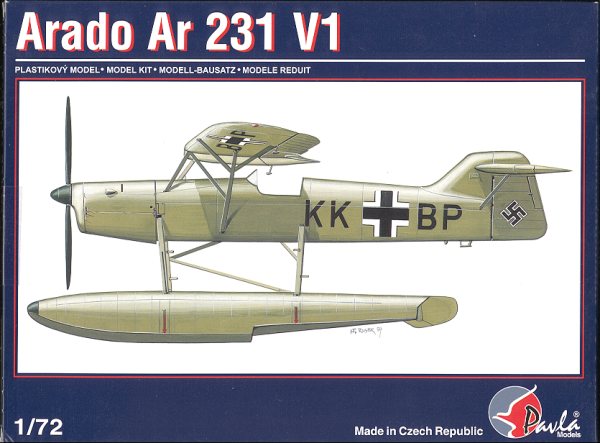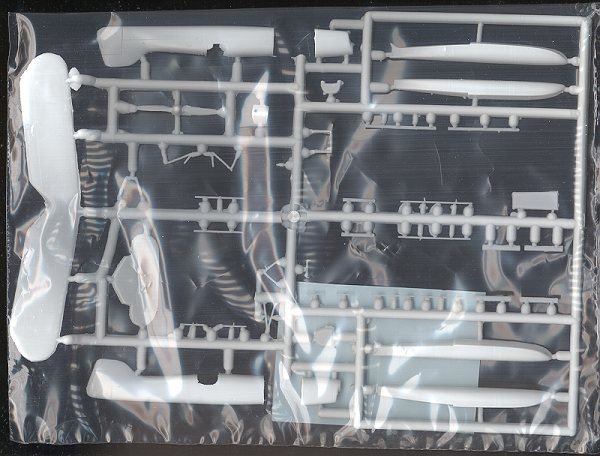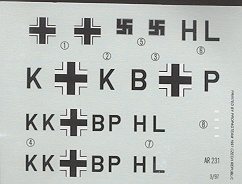
|
KIT: |
Pavla 1/72 Arado Ar-231 |
|
KIT # |
72014 |
|
PRICE: |
$13.98 |
|
DECALS: |
One Aircraft |
|
REVIEW & |
|
|
NOTES: |
` |

|
HISTORY |
Prior to the start of WWII, it was felt that it would be an advantage to have a scouting aircraft that was capable of being carried aboard a submarine. This would effectively extend the visible range of the sub and allow for greater information regarding finding and eventually sinking enemy shipping. To the goal, a specification was presented to Arado in 1940 to build such a plane.
The requirement was that it be able to be stowed inside a 2 meter container. As such, it had to be simple in design and easily assembled for flight and stowage. Six prototypes were completed in 1941. The aircraft appearing rather odd with its kink in the wing to enhance stowage and the shortened tail fin. Since speed wasn't really a requirement, a 160 HP Hirth six cylinder inverted inline air-cooled engine was installed.
It was obvious from the beginning that this was a design that wasn't going to work well. It was difficult to handle both on the water and in the air. It was also realized that the U-boat would have to stay stationary during the recovery period, rendering it vulnerable to enemy attack. As a result, the program was cancelled in 1941, later to be replaced by the much more useful Focke-Achgelis Fa-330 towable helicopter.
However, the story of the Ar-231 does not end there. One was actually used by the auxiliary cruiser (often called 'Q-ships'), Stier and perhaps a few other similar ships during WWII. The main difference in the aircraft was the addition of small plates on the end of shortened tailplanes (undoubtedly to improve stability). From the photos I have seen of these planes, only wing insignia was carried with the fuselage and fin being bare of any markings. I'd be interested in hearing from anyone with additional info on operational use of this interesting little floatplane.
|
THE KIT |

Pavla's 231 is typical of the genre in that it is on one large sprue with a small etched metal fret, vacuformed canopy and super decals by Propagteam. The plastic itself has a lot of flash and other imperfections. Attachment points are thick and it will be a challenge to get the thin struts removed from them without breaking them. I suggest Contrail struts or a similar aftermarket material as you'll undoubtedly need it. The surface detailing is quite well done, consisting of very fine engraved lines which will soon disappear under any filler and sanding, which these kits generally require.
 The instructions are more than
adequate to build the aircraft. Considering that most of the braces are made up
of multiple sections of plastic strut, the instructions are very helpful in
showing the complex construction process. Colors are not much of a problem as
just about everything is RLM 02 grey other than an RLM 70 prop. Decals are for
one aircraft, the prototype and are superbly printed. Unlike most Czech kits,
this one has a complete swastika provided. Interestingly, the instrument panel
is provided on a piece of paper. Apparently you are supposed to glue it to the
plastic backing provided!
The instructions are more than
adequate to build the aircraft. Considering that most of the braces are made up
of multiple sections of plastic strut, the instructions are very helpful in
showing the complex construction process. Colors are not much of a problem as
just about everything is RLM 02 grey other than an RLM 70 prop. Decals are for
one aircraft, the prototype and are superbly printed. Unlike most Czech kits,
this one has a complete swastika provided. Interestingly, the instrument panel
is provided on a piece of paper. Apparently you are supposed to glue it to the
plastic backing provided!
|
CONCLUSIONS |
An easy kit to build this one will not be. Thanks to the myriad of struts and braces, it will probably do well to build a jig for it. I'd also suggest adding some weight in the front of the floats. However, it is a subject that one does not see too often and is bound to bring a lot of comments when finally displayed.
|
REFERENCES |
German Aircraft of the Second World War, 3rd edition, 1978
German Raiders, Paul Schmalenback, 1979
Review kit courtesy of me and my wallet!
If you would like your product reviewed fairly and quickly by a site that averages thousands of visits a day, please contact me or see other details in the Note to Contributors.